A Case Analysis of Dust Weather and Prediction of PM10 Concentration Based on Machine Learning at the Tibetan Plateau
Abstract
:1. Introduction
2. Materials and Methods
2.1. Data Sources and Integration
2.2. Model Introduction
2.2.1. Introduction to Machine Learning Methods
2.2.2. HYSPLIT Model
2.3. Evaluation and Analysis Approach
2.3.1. Air Quality Standards
2.3.2. Dust Weather Grade Standard
2.3.3. Valuation Method
3. Analysis of Dust Weather from
3.1. Dust Weather in the Northeast of Tibet Plateau
3.1.1. Dust Distribution
3.1.2. Surface Meteorological Conditions
3.1.3. 700 hPa and 500 hPa Meteorological Conditions
3.2. HYSPLIT Backward Trajectory Model Analysis in Xining City
3.3. Analysis of Meteorological Elements in Xining City
3.4. Comparison of PM10 Concentrations between Xining and Zhangye Cities
4. Prediction Based on Machine Learning
4.1. Eigenvalues Selection
4.2. Methods Optimization
4.3. Prediction Results of PM10 Concentration in the Dust Weather
4.4. Prediction Results of PM10 Concentration in Clean Period
5. Conclusions and Discussion
- (1)
- The main mechanisms influencing the dust were as follows: The 24-h pressure change was positive when the front intruded on the surface; the convergence of vector winds with a sudden drop in temperature and humidity led by a trough at 700 hPa; a “two troughs and one ridge” weather situation appeared at 500 hPa while the cold advection behind the trough was strong and a cyclone vorticity was formed in the east of Inner Mongolia;
- (2)
- The trajectory of air mass from the Hexi Corridor was the main air mass path influencing Xining City, in this case, since a significant lag in the peak of PM10 concentration appeared in Xining City when compared with Zhangye City;
- (3)
- The Multiple Linear Regression was not only timely and effective in predicting the PM10 concentration but had great abilities for anticipating the transition period of particle concentration and the appearance date of maximum values in such dust weather;
- (4)
- The MA and MP during the clean period were much lower than that during the dust period; the PM10 of Zhangye City as an eigenvalue played an important role in predicting the PM10 of Xining City even during the clean period. In contrast to the dust period, the prediction effect of Random Forest was superior to Multiple Linear Regression during the clean period.
Author Contributions
Funding
Informed Consent Statement
Data Availability Statement
Acknowledgments
Conflicts of Interest
References
- Kurosaki, Y.; Mikami, M. Recent frequent dust events and their relation to surface wind in East Asia. Geophys. Res. Lett. 2003, 30, 1736. [Google Scholar] [CrossRef]
- Guo, L.; Fan, B.; Zhang, F.; Jin, Z.; Lin, H. The clustering of severe dust storm occurrence in China from 1958 to 2007. J. Geophys. Res. Atmos. 2018, 123, 8035–8046. [Google Scholar] [CrossRef]
- Shao, Y. Physics and Modelling of Wind Erosion; Kluwer Academic: Dordrecht, The Netherlands, 2009. [Google Scholar]
- De Villiers, M.P.; Heerden, J.V. Dust storms and dust at Abu Dhabi International Airport. Weather 2007, 62, 339–343. [Google Scholar] [CrossRef] [Green Version]
- Sissakian, V.K.; Al-Ansari, N.; Knutsson, S. Sand and dust storm events in Iraq. Nat. Sci. 2013, 5, 1084–1094. [Google Scholar] [CrossRef] [Green Version]
- Stefanski, R.; Sivakumar, M.V.K. Impacts of sand and dust storms on agriculture and potential agricultural applications of a SDSWS. IOP Conf. Ser. Earth Environ. Sci. 2009, 7, 12–16. [Google Scholar] [CrossRef]
- Meo, S.A.; Almutari, F.J.; Abukhalaf, A.A.; Alessa, O.M.; Al-Khlaiwi, T.; Meo, A.S. Sandstorm and its effect on particulate matter PM 2.5, carbon monoxide, ni-trogen dioxide, ozone pollutants and SARS-CoV-2 cases and deaths. Sci. Total Environ. 2021, 795, 148764. [Google Scholar] [CrossRef]
- Goudie, A.S.; Middleton, N.J. Saharan dust storms: Nature and consequences. Earth Sci. Rev. 2001, 56, 179–204. [Google Scholar] [CrossRef]
- Ho, H.M.; Rao, C.Y.; Hsu, H.H.; Chiu, Y.H.; Liue, C.M.; Chaoc, H.J. Characteristics anddeterminants of ambient fungal spores in Hualien Taiwan. Atmos. Environ. 2005, 39, 5839–5850. [Google Scholar] [CrossRef]
- Fang, X.; Han, Y.; Jinghui, M.A.; Song, L.; Yang, S.; Zhang, X. Dust storms and loess accumulation on the Tibetan Plateau: A case study of dust event on 4 March 2003 in Lhasa. Sci. Bull. 2004, 49, 953–960. [Google Scholar] [CrossRef]
- Peng, S.; Li, Y.; Liu, H.; Han, Q.; Zhang, X.; Feng, Z.; Chen, D.; Ye, W.; Zhang, Y. Formation and evolution of mountainous aeolian sediments in the northern Tibet Plateau and their links to the Asian winter monsoon and westerlies since the Last Glacial Maximum. Prog. Phys. Geogr. 2021, 46, 43–60. [Google Scholar] [CrossRef]
- Shao, Y. Northeast Asian dust storms: Real-time numerical prediction and validation. J. Geophys. Res. 2003, 108, AAC 3-1. [Google Scholar] [CrossRef] [Green Version]
- Zhao, Y.; Li, H.J.; Huang, A.N.; He, Q.; Huo, W.; Wang, M. Relationship between thermal anomalies in Tibetan Plateau and summer dust storm frequency over Tarim Basin, China. J. Arid Land 2013, 5, 25–31. [Google Scholar] [CrossRef] [Green Version]
- Sun, Z.B.; Wang, H.; Guo, C.; Wu, J.; Cheng, T.; Li, Z.-M. Barrier effect of terrain on cold air and return flow of dust air masses. Atmos. Res. 2019, 220, 81–91. [Google Scholar]
- Wang, T.H.; Tang, J.Y.; Sun, M.X.; Liu, X.; Huang, Y.; Huang, J.; Han, Y.; Cheng, Y.; Huang, Z.; Li, J. Identifying a transport mechanism of dust aerosols over South Asia to the Tibetan Plateau: A case study. Sci. Total Environ. 2021, 758, 143714. [Google Scholar] [CrossRef] [PubMed]
- Zhao, J.; Ma, X.; Wu, S.; Sha, T. Dust emission and transport in Northwest China: WRF-Chem simulation and comparisons with multi-sensor observations. Atmos. Res. 2020, 241, 104978. [Google Scholar] [CrossRef]
- Singh, C.; Singh, S.K.; Chauhan, P.; Budakoti, S. Simulation of an extreme dust episode using WRF-CHEM based on optimal ensemble approach. Atmos. Res. 2020, 249, 105296. [Google Scholar] [CrossRef]
- Li, J.; Man, S.W.; Lee, K.H.; Nichol, J.; Chan, P.W. Review of dust storm detection algorithms for multispectral satellite sensors. Atmos. Res. 2021, 250, 105398. [Google Scholar] [CrossRef]
- Ranjan, A.K.; Patra, A.K.; Gorai, A.K. A Review on Estimation of Particulate Matter from Satellite-Based Aerosol Optical Depth: Data, Methods, and Challenges. J. Atmos. Sci. 2021, 57, 679–699. [Google Scholar] [CrossRef]
- Qing, X.; Zheng, S. A New Method for Initialising the K-Means Clustering Algorithm; IEEE Computer Society: Washington, DC, USA, 2009. [Google Scholar]
- Lin, P.; Hu, G.; Li, C.; Li, L.; Xiao, Y.; Tse, K.T.; Kwok, K.C. Machine learning-based prediction of crosswind vibrations of rectangular cylinders. J. Wind Eng. Ind. Aerodyn. 2021, 211, 104549. [Google Scholar] [CrossRef]
- Xi, X.; Zhao, W.; Rui, X.; Wang, Y.; Bai, X.; Yin, W.; Don, J. A comprehensive evaluation of air pollution prediction improvement by a machine learning method. In Proceedings of the 2015 IEEE International Conference on Service Operations And Logistics, And Informatics (SOLI), Hammamet, Tunisia, 15–17 November 2015; pp. 176–181. [Google Scholar] [CrossRef]
- Tao, J. Elevation-dependent temperature change in the Qinghai-Xizang Plateau grassland during the past decade. Theor. Appl. Climatol. 2014, 117, 61–71. [Google Scholar] [CrossRef]
- Al Murayziq, T.S.; Kapetanakis, S.; Petridis, M. Intelligent Signal Processing for Dust Storm Prediction Using Ensemble Case-Based Reasoning. In Proceedings of the 2017 IEEE 29th International Conference on Tools with Artificial Intelligence (ICTAI), Boston, MA, USA, 6–8 November 2017; pp. 1267–1271. [Google Scholar] [CrossRef]
- Kaimian, H.; Li, Q.; Wu, C.; Qi, Y.; Mo, Y.; Chen, G.; Zhang, X.; Sachdeva, S. Evaluation of Different Machine Learning Approaches in Forecasting PM2.5 Mass Concentrations. Aerosol Air Qual. Res. 2019, 19, 1400–1410. [Google Scholar] [CrossRef] [Green Version]
- Yang, G.; Lee, H.M.; Lee, G. A Hybrid Deep Learning Model to Forecast Particulate Matter Concentration Levels in Seoul, South Korea. Atmosphere 2020, 11, 348. [Google Scholar] [CrossRef] [Green Version]
- Feng, X.; Li, Q.; Zhu, Y.; Hou, J.; Jin, L.; Wang, J. Artificial neural networks forecasting of PM2.5 pollution using air mass trajectory based geographic model and wavelet transformation. Atmos. Environ. 2015, 107, 118–128. [Google Scholar] [CrossRef]
- Huang, L.; Zhang, C.; Bi, J. Development of land use regression models for PM2.5, SO2, NO2 and O3 in Nanjing, China. Environ. Res. 2017, 158, 542–552. [Google Scholar] [CrossRef] [PubMed]
- Perez, P.; Menares, C. Forecasting of hourly PM2.5 in south-west zone in Santiago de Chile. Aerosol Air Qual. Res. 2018, 18, 2666–2679. [Google Scholar] [CrossRef] [Green Version]
- Li, J.; Shao, X.; Zhao, H. An Online Method Based on Random Forest for Air Pollutant Concentration Forecasting. In Proceedings of the 37th China Control Conference, Wuhan, China, 25–27 July 2018. [Google Scholar]
- Jiang, F.; Qiao, Y.; Jiang, X.; Tian, T. MultiStep Ahead Forecasting for Hourly PM10 and PM2.5 Based on Two-Stage Decomposition Embedded Sample Entropy and Group Teacher Optimization Algorithm. Atmosphere 2021, 12, 64. [Google Scholar] [CrossRef]
- Park, S.; Kim, M.; Kim, M.; Namgung, H.G.; Kim, K.T.; Cho, K.H.; Kwon, S.B. Predicting PM 10 concentration in Seoul metropolitan subway stations using artifificial neural network (ANN). J. Hazard. Mater. 2018, 341, 75–82. [Google Scholar] [CrossRef]
- Yumimoto, K.; Murakami, H.; Tanaka, T.Y.; Sekiyama, T.T.; Ogi, A.; Maki, T. Forecasting of Asian dust storm that occurred on May 10–13, 2011, using an ensemble-based data assimilation system. J. Part. 2016, 28, 121–130. [Google Scholar] [CrossRef]
- Xu, Y.; Xu, E. ARIMA and Multiple Regression Additive Models for PM2.5 Based on Linear Interpolation. In Proceedings of the 2020 In-ternational Conference on Big Data & Artificial Intelligence & Software Engineering (ICBASE), Bangkok, Thailand, 30 October–1 November 2020; pp. 266–269. [Google Scholar] [CrossRef]
- Chen, J.; Wang, J. Prediction of PM2.5 Concentration Based on Multiple Linear Regression. In Proceedings of the 2019 International Conference on Smart Grid and Electrical Automation (ICSGEA), Xiangtan, China, 10–11 August 2019. [Google Scholar]
- Sinnott, R.O.; Guan, Z. Prediction of Air Pollution through Machine Learning Approaches on the Cloud. In Proceedings of the 2018 IEEE/ACM 5th International Conference on Big Data Computing Applications and Technologies (BDCAT), Zurich, Switzerland, 17–20 December 2018. [Google Scholar]
- Vlachogiannis, D.; Sfetsos, A. Time Series Forecasting of Hourly PM10 Values: Model Intercomparison and the Development of Localized Linear Approaches. In Air Pollution; WIT Press: Southampton, UK, 2006. [Google Scholar]
- Abraham, A.; Pedregosa, F.; Eickenberg, M.; Gervais, P.; Mueller, A.; Kossaifi, J.; Gramfort, A.; Thirion, B.; Varoquaux, G. Machine Learning for Neuroimaging with Scikit-Learn. Front. Neuroinform. 2013, 8, 14. [Google Scholar] [CrossRef] [Green Version]
- Tran, M.K.; Panchal, S.; Chauhan, V.; Brahmbhatt, N.; Mevawalla, A.; Fraser, R.; Fowler, M. Python-based scikit-learn machine learning models for thermal and electrical performance prediction of high-capacity lithium-ion battery. Int. J. Energy Res. 2021, 46, 786–794. [Google Scholar] [CrossRef]
- Sousa, S.; Martins, F.G.; Alvim-Ferraz, M.; Pereira, M.C. Multiple linear regression and artificial neural networks based on principal components to predict ozone concentrations. Environ. Model. Softw. 2007, 22, 97–103. [Google Scholar] [CrossRef]
- Albergaria, J.T.; Martins, F.G.; Alvim-Ferraz, M.; Delerue-Matos, C. Multiple Linear Regression and Artificial Neural Networks to Predict Time and Efficiency of Soil Vapor Extraction. Water Air Soil Pollut. 2014, 225, 1–9. [Google Scholar] [CrossRef] [Green Version]
- Baczek, T.; Wiczling, P.; Marsza, M.; Heyden, Y.V.; Kaliszan, R. Prediction of peptide retention at different HPLC conditions from multiple linear regression models. J. Proteome Res. 2005, 4, 555–563. [Google Scholar] [CrossRef] [PubMed]
- Wessel, M.D.; Jurs, P.C. Prediction of Reduced Ion Mobility Constants from Structural Information Using Multiple Linear Regression Analysis and Computational Neural Networks. Anal. Chem. 1994, 66, 2480–2487. [Google Scholar] [CrossRef]
- Breiman, L.; Friedman, J.H.; Olshen, R.A.; Stone, C.J. Classification and Regression Trees; Wadsworth Inc.: Belmont, CA, USA, 1984. [Google Scholar]
- Hou, W.; Li, Z.; Zhang, Y.; Xu, H.; Zhang, Y.; Li, K.; Li, D.; Wei, P.; Ma, Y. Using support vector regression to predict PM10 and PM2.5. IOP Conf. Ser. Earth Environ. Sci. 2014, 17, 012268. [Google Scholar]
- Keller, J.M.; Gray, M.R.; Givens, J.A. A fuzzy K-nearest neighbor algorithm. IEEE Trans. Syst. Man Cybern. 2012, 4, 580–585. [Google Scholar] [CrossRef]
- Maltamo, M.; Kangas, A. Methods based on k-nearest neighbor regression in the prediction of basal area diameter distribution. Can. J. For. Res. 2011, 28, 1107–1115. [Google Scholar] [CrossRef]
- Chan, C.W.; Paelinckx, D. Evaluation of Random Forest and Adaboost tree-based ensemble classification and spectral band selection for ecotope mapping using airborne hyperspectral imagery. Remote Sens. Environ. 2008, 112, 2999–3011. [Google Scholar] [CrossRef]
- Xia, L.; Bai, R. Freight Vehicle Travel Time Prediction Using Gradient Boosting Regression Tree. In Proceedings of the IEEE International Conference on Machine Learning & Applications, Anaheim, CA, USA, 18–20 December 2016. [Google Scholar]
- Sousa, P.M.; Trigo, R.M.; Barriopedro, D.; Soares, P.M.; Ramos, A.M.; Liberato, M.L. Responses of European precipitation distributions and regimes to different blocking locations. Clim. Dyn. 2016, 48, 1–20. [Google Scholar] [CrossRef] [Green Version]
- GB 3095-2012; Ambient Air Quality Standards. China Environmental Science Press: Beijing, China, 2012.
- GB/t20480-2017; Classification of Sand and Dust Weather. China National Standardization Administration Committee: Beijing, China, 2017.
- Zhang, P.; Wu, H.N.; Chen, R.P.; Chan, T.H. Hybrid meta-heuristic and machine learning algorithms for tunneling-induced settlement prediction: A comparative study. Tunn. Undergr. Space Technol. 2020, 99, 103383. [Google Scholar] [CrossRef]
- Wang, S.; Zhuang, J.; Zheng, J.; Fan, H.; Kong, J.; Zhan, J. Application of Bayesian hyperparameter optimized random forest and XGBoost model for landslide susceptibility mapping. Front. Earth Sci. 2021, 9, 617. [Google Scholar] [CrossRef]
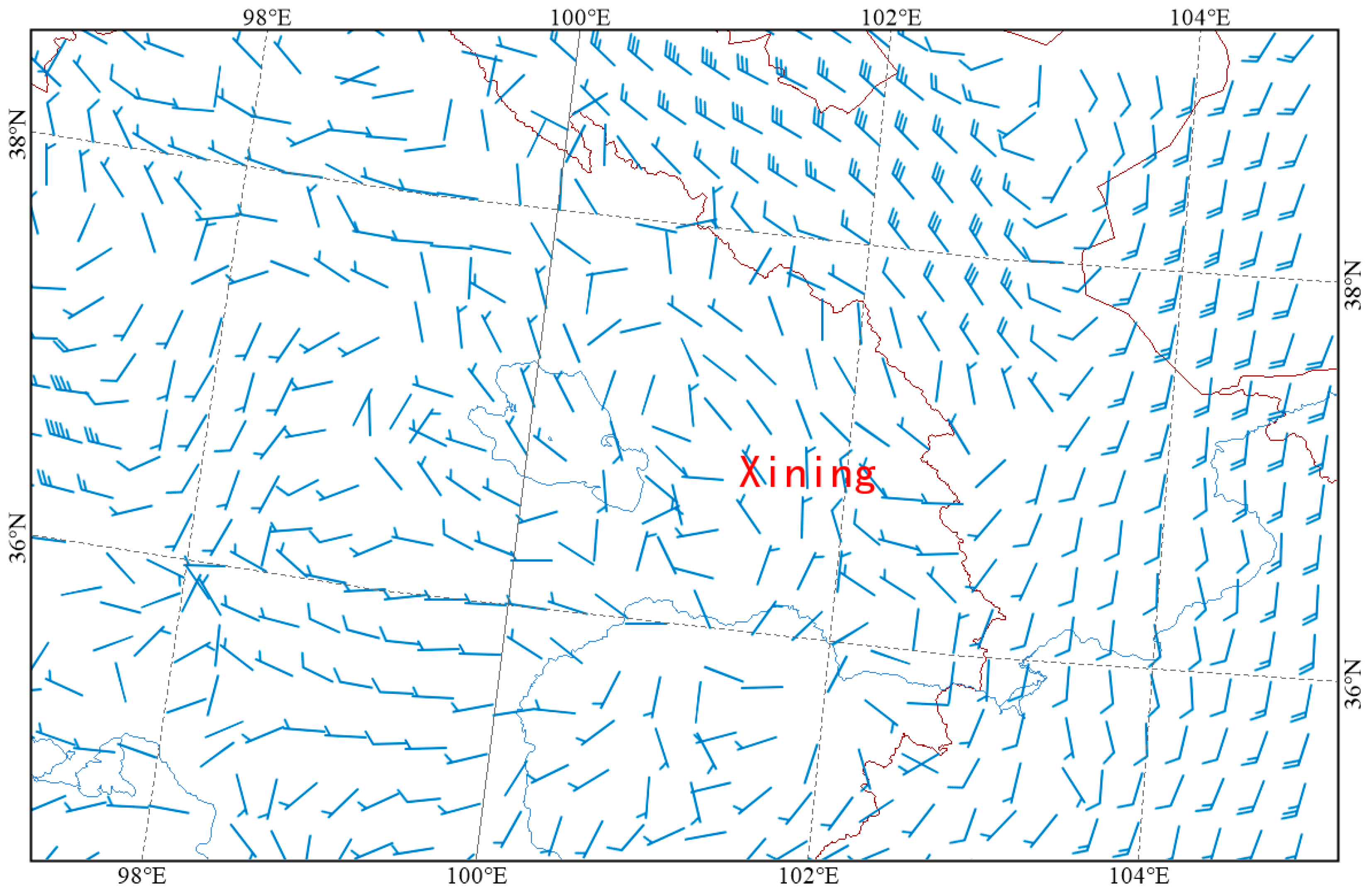
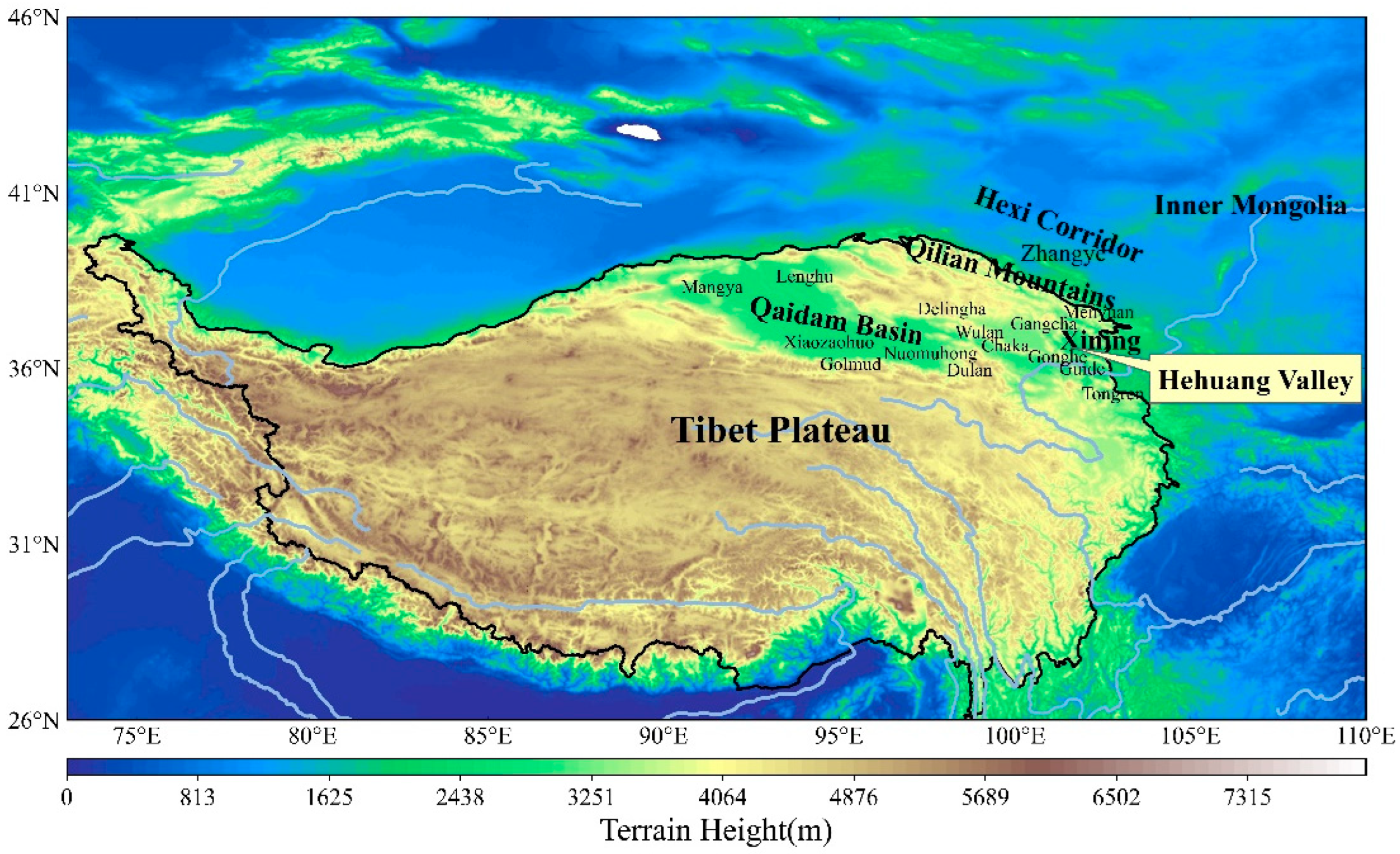

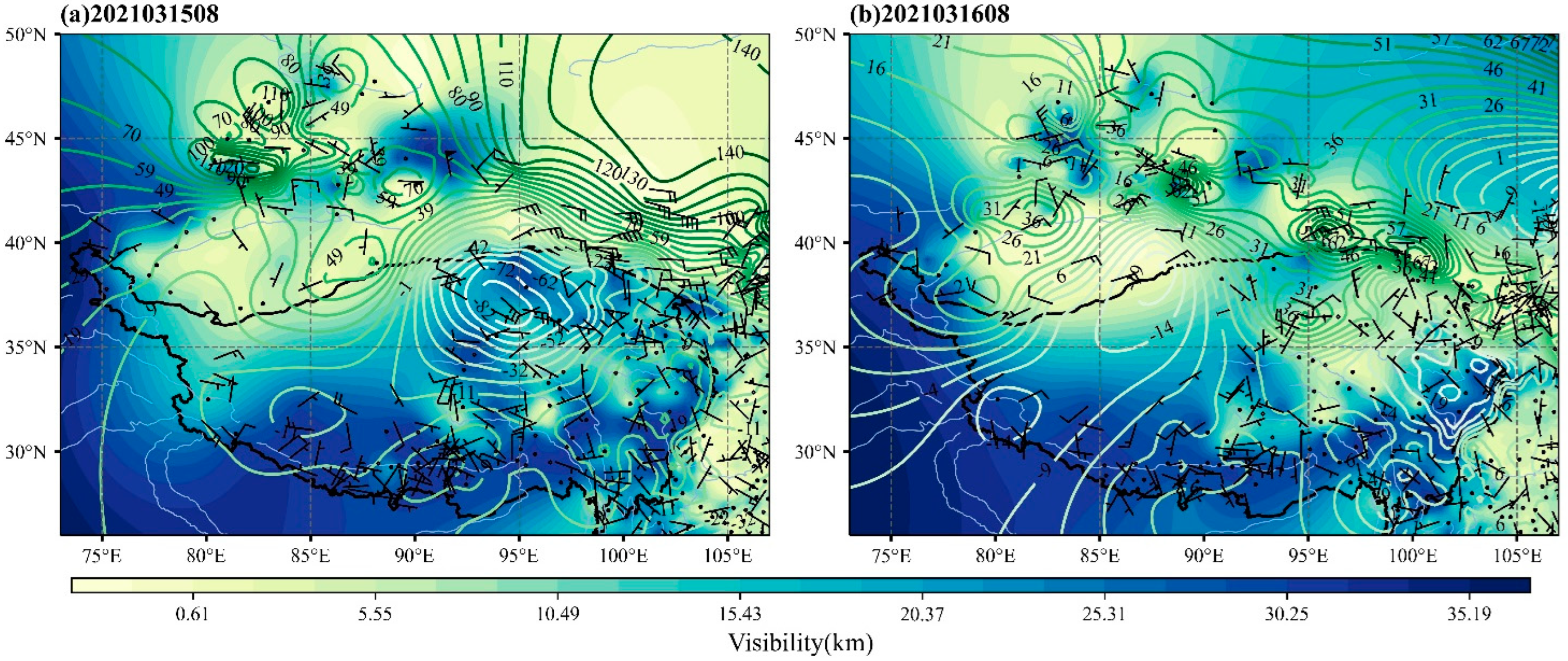
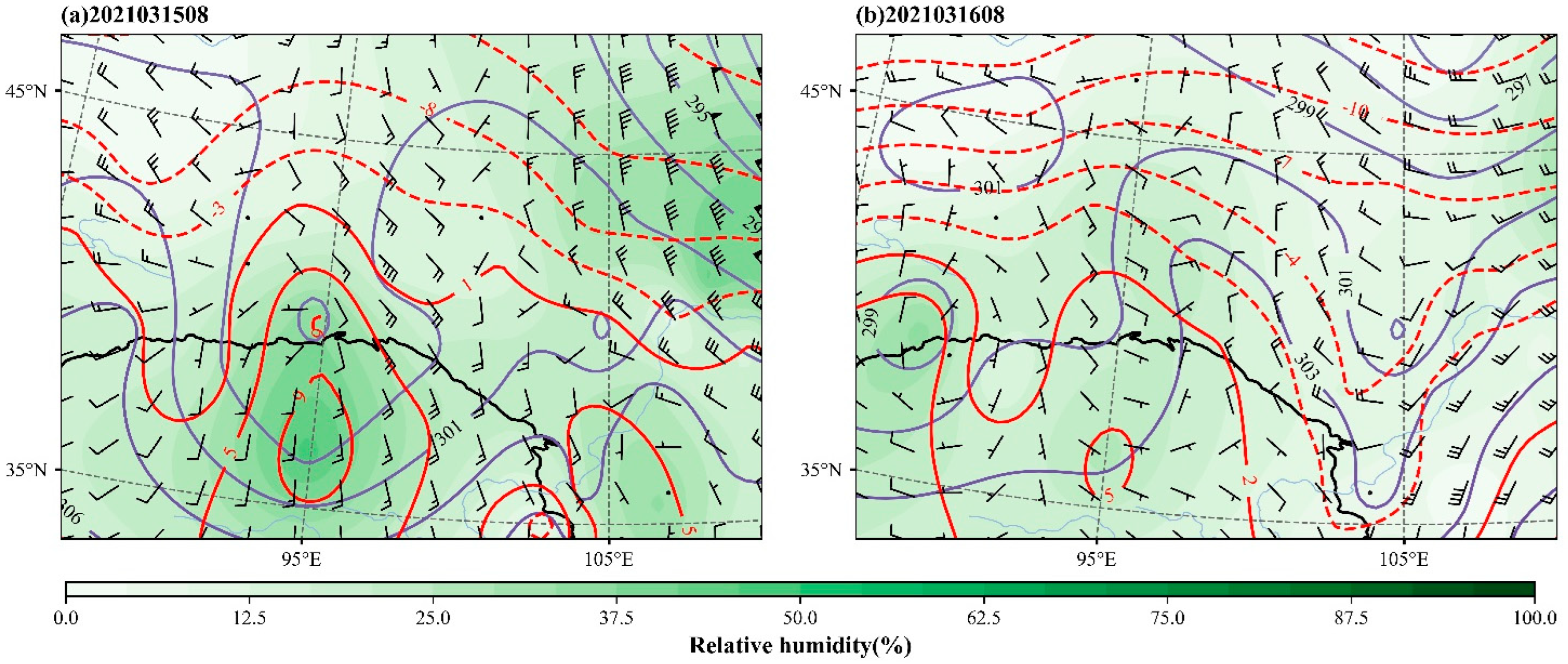
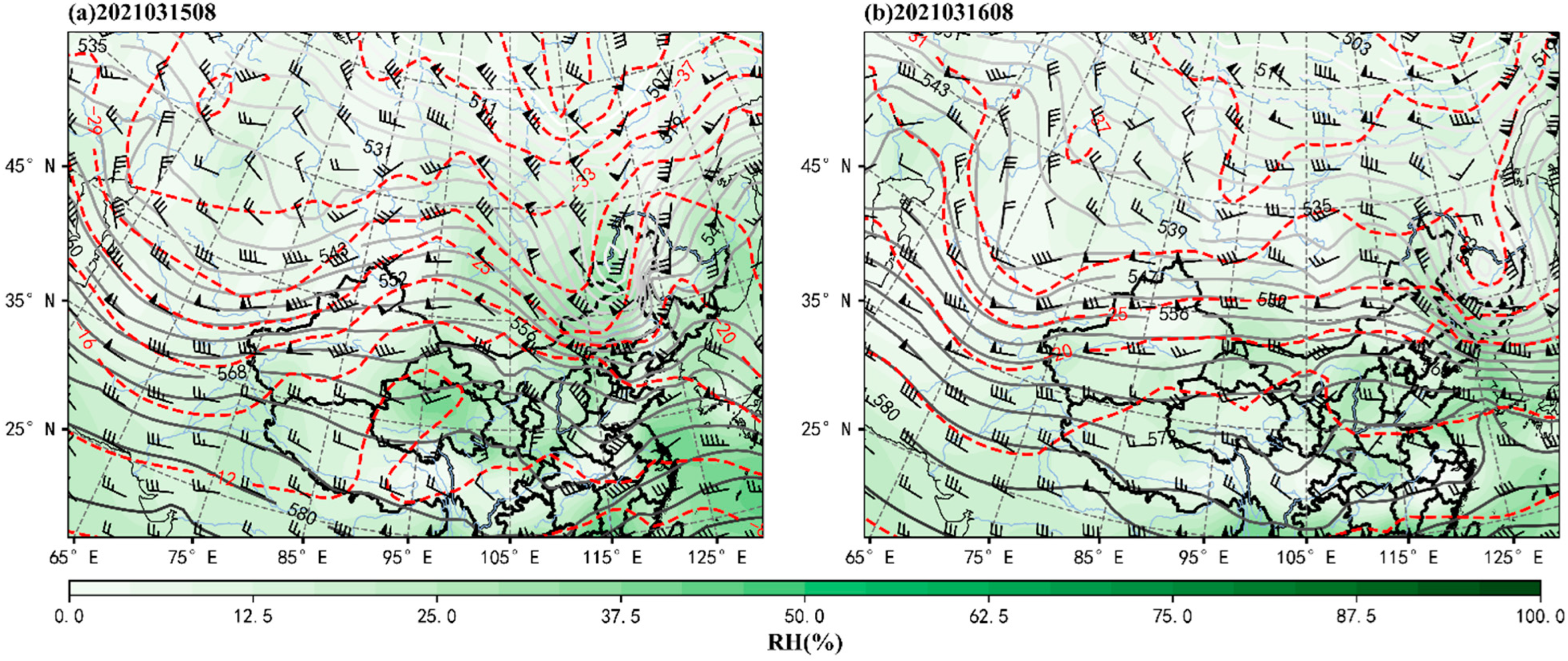
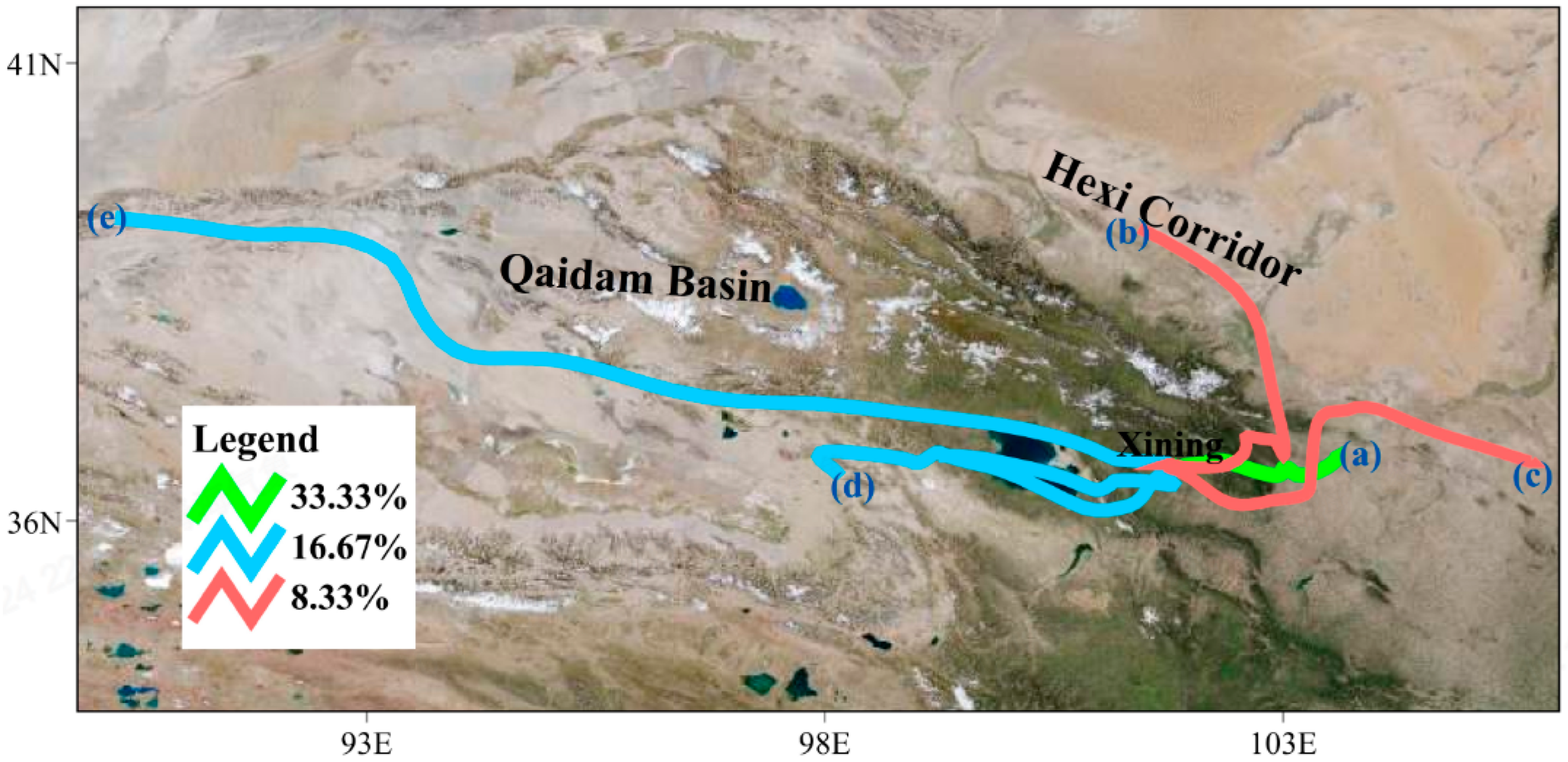
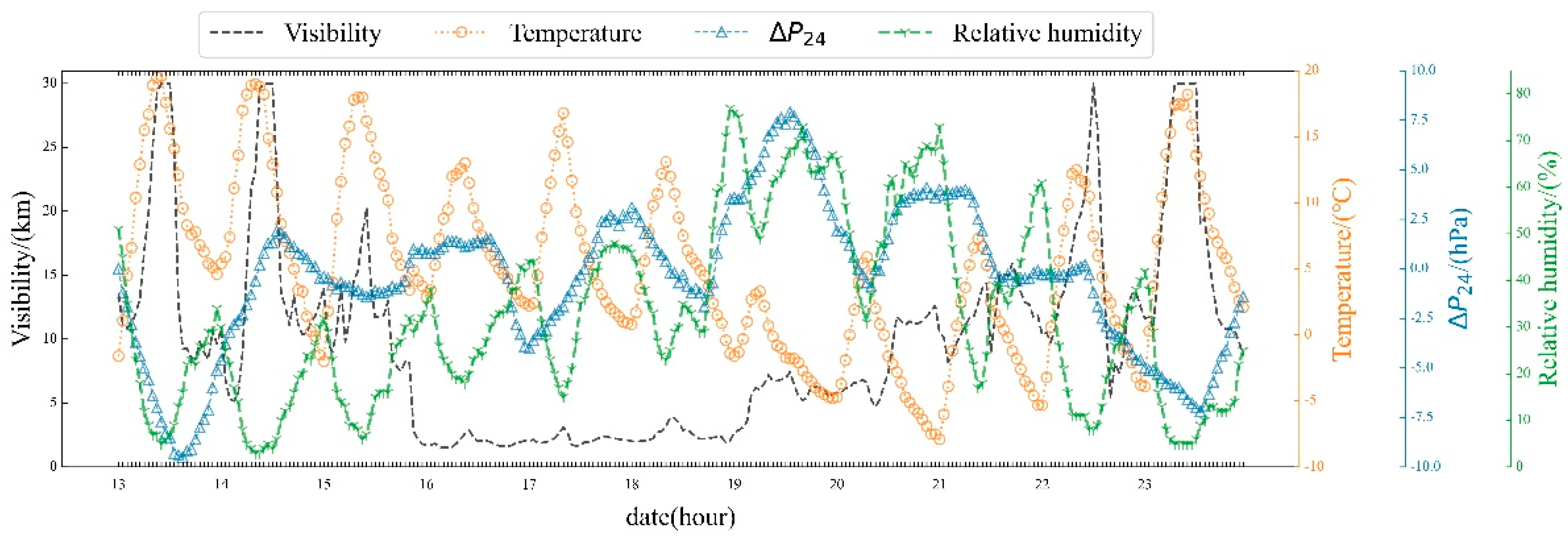
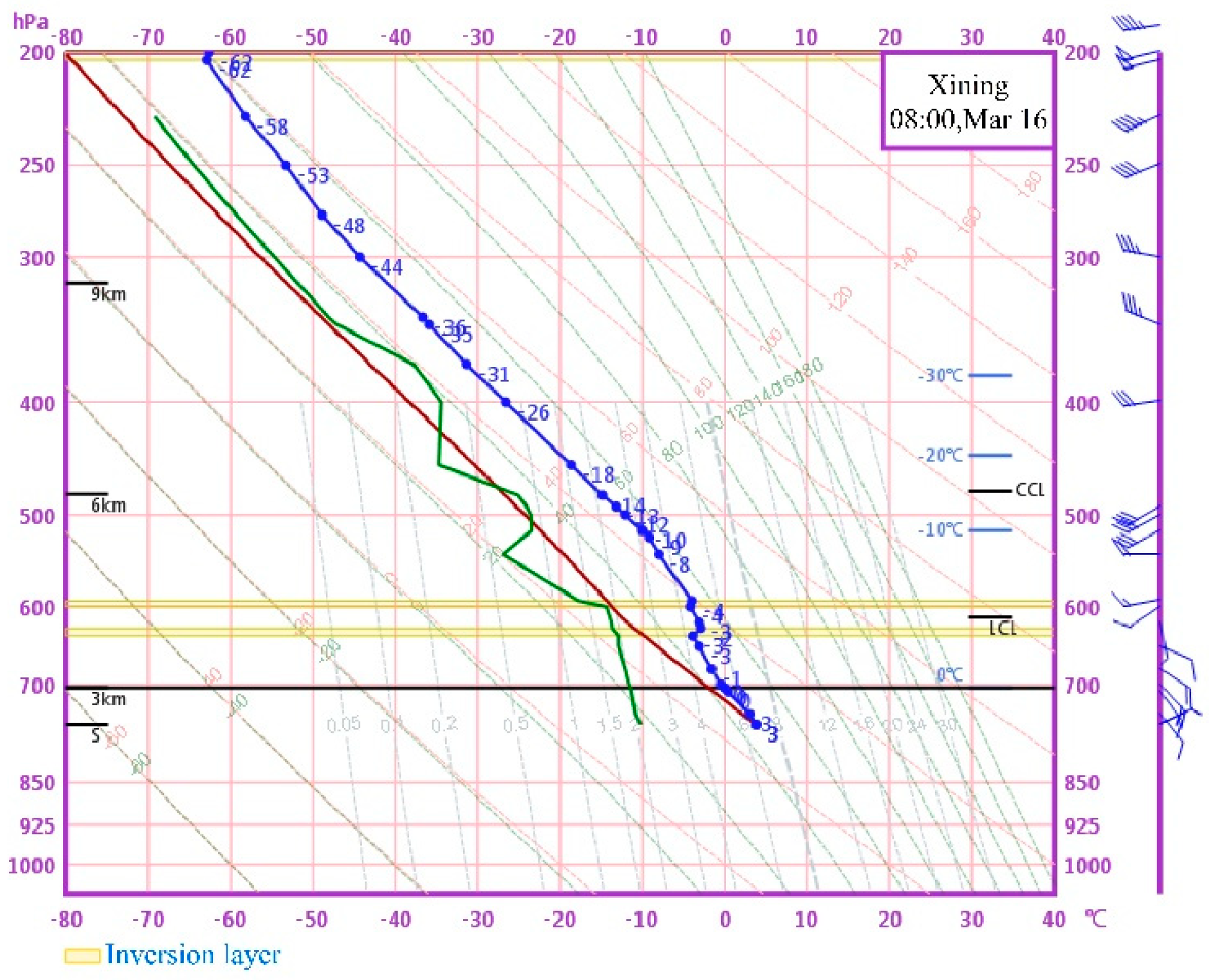
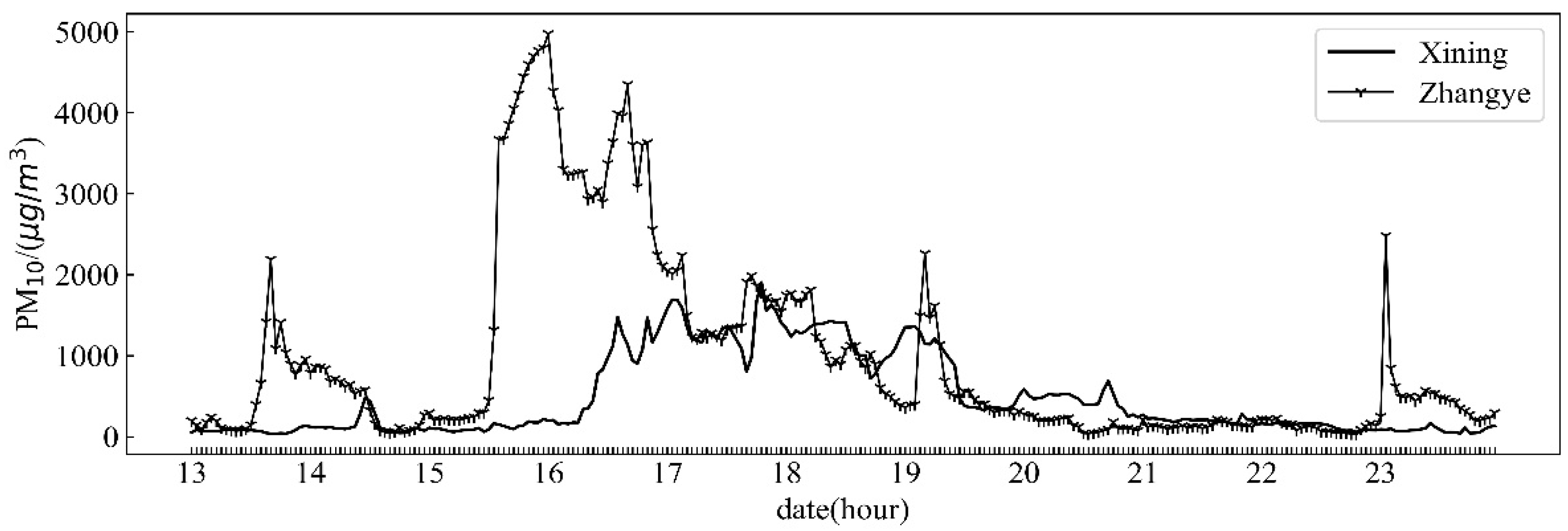


| Air Quality Index | Air Quality Grade Level | Air Quality Category | Air Quality Sub-Index | 24-h Mean Concentration of PM10 (Unit: µg/m3) |
|---|---|---|---|---|
| (0,50] | Ⅰ | Excellent | (0,50] | (0,50] |
| (50,100] | Ⅱ | Good | (50,100] | (50,150] |
| (100,150] | Ⅲ | Mild pollution | (100,150] | (150,250] |
| (150,200] | Ⅳ | Moderate pollution | (150,200] | (250,350] |
| (200,300] | Ⅴ | Heavy pollution | (200,300] | (350,420] |
| (300,400] | Ⅵ | Serious pollution | (300,400] | (420,500] |
| (400,500] | Ⅵ | Serious pollution | (400,500] | (500,600] |
| >500 | Ⅵ | Serious pollution | >500 | >600 |
| Weather Phenomenon | Weather Conditions | Visibility Unit: km |
|---|---|---|
| Dustfall | Calm or wind speed ≤3 m/s, dust float in the air | ≤10 |
| Blowing sand | Wind blows dust from the surface, making the air turbid | [1,10) |
| Sandstorm | Strong wind blows dust from the surface, making the air quite turbid | <1 |
| Strong sandstorm | Quite strong wind blows dust from the surface, making the air very turbid | <0.5 |
| Extreme strong sandstorm | Extreme strong wind blows dust from the surface, making the air extremely turbid | <0.05 |
| Dataset | Variable | Unit | Spatial Resolution | Temporal Resolution | Data Source |
|---|---|---|---|---|---|
| Observations (PM10) | PM10 | μg/m3 | Zhangye | Hourly | CNEMC |
| Prediction Products (700 hPa) | u-component of wind | m/s | 0.25° × 0.25° | 3-Hourly | ECMWF |
| v-component of wind | m/s | ||||
| Temperature | °C | ||||
| Relative humidity | % | ||||
| Prediction Products (surface) | ∆P24 | hPa | 0.125° × 0.125 |
| Number | Equation | MA |
|---|---|---|
| Ⅰ | 20.06 | |
| Ⅱ | 20.07 | |
| Ⅲ | 20.06 | |
| Ⅳ | 19.85 | |
| Ⅴ | 19.84 | |
| Ⅵ | 19.89 |
| Methods | IA | Correlation Coefficient | MA | MP (%) |
|---|---|---|---|---|
| RF | 0.38 | 0.59 | 423 | 53 |
| MLR | 0.83 | 0.93 | 192 | 39 |
| SVR | 0.34 | −0.57 | 452 | 61 |
| KNN | 0.39 | 0.33 | 427 | 54 |
| Ada | 0.37 | 0.48 | 432 | 56 |
| GBRT | 0.39 | 0.52 | 427 | 54 |
| ARIMA | 0.34 | 0.10 | 458 | 64 |
| Methods | IA | Correlation Coefficient | MA | MP (%) |
|---|---|---|---|---|
| RF | 0.99 | 0.76 | 11 | 16 |
| MLR | 0.98 | 0.78 | 14 | 20 |
Publisher’s Note: MDPI stays neutral with regard to jurisdictional claims in published maps and institutional affiliations. |
© 2022 by the authors. Licensee MDPI, Basel, Switzerland. This article is an open access article distributed under the terms and conditions of the Creative Commons Attribution (CC BY) license (https://creativecommons.org/licenses/by/4.0/).
Share and Cite
Tan, C.; Chen, Q.; Qi, D.; Xu, L.; Wang, J. A Case Analysis of Dust Weather and Prediction of PM10 Concentration Based on Machine Learning at the Tibetan Plateau. Atmosphere 2022, 13, 897. https://doi.org/10.3390/atmos13060897
Tan C, Chen Q, Qi D, Xu L, Wang J. A Case Analysis of Dust Weather and Prediction of PM10 Concentration Based on Machine Learning at the Tibetan Plateau. Atmosphere. 2022; 13(6):897. https://doi.org/10.3390/atmos13060897
Chicago/Turabian StyleTan, Changrong, Qi Chen, Donglin Qi, Liang Xu, and Jiayun Wang. 2022. "A Case Analysis of Dust Weather and Prediction of PM10 Concentration Based on Machine Learning at the Tibetan Plateau" Atmosphere 13, no. 6: 897. https://doi.org/10.3390/atmos13060897
APA StyleTan, C., Chen, Q., Qi, D., Xu, L., & Wang, J. (2022). A Case Analysis of Dust Weather and Prediction of PM10 Concentration Based on Machine Learning at the Tibetan Plateau. Atmosphere, 13(6), 897. https://doi.org/10.3390/atmos13060897





